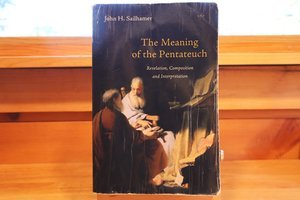Exploring the Foundations of the Christian Faith: John H. Sailhamer's "The Meaning of the Pentateuch"
John H. Sailhamer’s The Meaning of the Pentateuch is considered a monumental work in biblical studies, providing a fresh approach to the interpretation of the Torah. Sailhamer argues that the Pentateuch is more than a historical or legal text—it is a theological document pointing to the Messiah and the gospel. His focus is on the final, canonical form of the text, suggesting that the Pentateuch was composed in two stages: initially by Moses and later completed by an inspired editor or prophet at the end of the Old Testament period.
Published by IVP Academic in 2009, this book represents the culmination of Sailhamer's lifelong study of the Old Testament, particularly the Pentateuch. Here's a detailed examination of its contents and significance:
Key Themes and Contributions
Messianic Focus: Sailhamer emphasizes the messianic thread throughout the Pentateuch. He interprets key texts like Genesis 49 and Numbers 24 as foreshadowing a future king, holding that the biblical authors intentionally highlighted these connections. Sailhamer highlights how the Pentateuch points towards messianic fulfillment, weaving themes of covenant, promise, and redemption throughout the narrative.
Textual Composition: Sailhamer distinguishes between "Pentateuch 1.0" (the Mosaic composition) and "Pentateuch 2.0" (the later editorial work). He proposes that this compositional strategy reflects theological concerns, aiming to guide readers toward meditating on God’s promises and the covenant.
Authorial Intent: A significant part of Sailhamer's methodology is his focus on the intent of the biblical author, advocating for a return to the text's verbal meaning over historical-critical methods that might prioritize the history behind the text.
Literary and Compositional Analysis: The book is divided into three parts, examining the approach to the text as revelation, the composition of the Pentateuch within the broader Tanak (Hebrew Bible), and its theological interpretation. Sailhamer introduces the concept of a singular authorial strategy behind the Pentateuch, suggesting it was composed with a specific theological message in mind.
Role of the Law: Sailhamer argues that the law was added progressively in response to Israel's sin, beginning with the Golden Calf incident. He suggests that God originally intended a covenant based on faith rather than a legal code, a controversial interpretation that challenges traditional views. His view is that after the sin of the golden calf, more laws were given to Israel. Then his opinions is that another set of laws was given to Israel when there was idolatry with goats mentioned in Leviticus 17:7. It’s a fascinating study.
Theological Approach: Sailhamer emphasizes a theological reading of the Pentateuch, focusing on it as divine revelation rather than just historical documentation. He argues for understanding the text's final form as a deliberate theological composition.
Significance in Biblical Studies:
Challenging Traditional Views: Sailhamer's work challenges some traditional evangelical views, particularly around Mosaic authorship and the composition process of the Pentateuch, by proposing a nuanced view where Moses wrote much, but not all, of the text.
Educational Value: For students and scholars, this book offers a rich framework for understanding Old Testament theology, hermeneutics, and the intertextual connections within the Hebrew Bible.
Relevance to Christian Theology: By linking the Pentateuch's themes to New Testament fulfillment, Sailhamer provides a bridge for Christians to see the continuity of Scripture, emphasizing the Pentateuch's role in the Christian canon.
Structure of the Book:
Part One: Approaching the Text as Revelation - Here, Sailhamer establishes his methodological stance, advocating for interpreting the Pentateuch through the lens of divine communication.
Part Two: Rediscovering the Composition of the Pentateuch Within the Tanak - This section explores the literary techniques and structural elements that suggest a purposeful composition, including how later parts of the Hebrew Bible interact with the Pentateuch.
Part Three: Interpreting the Theology of the Pentateuch - Sailhamer unpacks the theological messages, focusing on themes like salvation, the law, and the anticipation of the Messiah.
Impact and Reception:
Critical Acclaim: The book has received positive reviews for its depth, challenging readers to rethink their approach to the Pentateuch. It's seen as a blend of traditional and critical scholarship, offering fresh insights.
Controversy: Some of Sailhamer's conclusions, especially regarding authorship and composition, have sparked debate among scholars who hold to more traditional views.
Educational Tool: Its use in seminaries and academic circles underscores its importance as both a resource for teaching and a catalyst for discussion on Old Testament theology.
"The Meaning of the Pentateuch" by John H. Sailhamer is more than an academic work; it's a journey into the heart of biblical revelation, composition, and interpretation. By offering a new perspective on these ancient texts, Sailhamer not only deepens our understanding of the Pentateuch but also enriches the broader study of Scripture. Whether one agrees with all his conclusions or not, the book stands as a significant contribution to biblical scholarship, urging a reexamination of how we read and understand the foundational texts of Judeo-Christian tradition.
John H. Sailhamer's "The Meaning of the Pentateuch: Revelation, Composition, and Interpretation" is a seminal work in biblical scholarship, providing an in-depth analysis of the first five books of the Bible. This article delves into the key aspects of Sailhamer's approach, the book's structure, and its impact on understanding the Torah from both a theological and literary perspective.
Overall, The Meaning of the Pentateuch is a valuable resource for scholars and students interested in a theological and literary approach to the Torah. It challenges readers to see the Pentateuch not as a relic of ancient history but as a living text pointing to the fulfillment of God’s promises in Christ.

